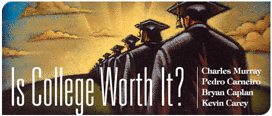One point I’d like Murray to expand upon is that a lot of people who start the BA don’t finish. He tells us that college…
…is still too intellectually demanding for a large majority of students, in an age when about 50 percent of all high school graduates are heading to four-year colleges the next fall. The result is lots of failure. Of those who entered a four-year college in 1995, only 58 percent had gotten their BA five academic years later. Another 14 percent were still enrolled. If we assume that half of that 14 percent eventually get their BAs, about a third of all those who entered college hoping for a BA leave without one, often after accumulating a large student-loan debt.
This is probably Murray’s strongest response to labor economists’ conventional wisdom that more people should be getting BAs because the rate of return is so high. [1] The problem: labor economists normally estimate the return to completed education. It only takes a small drop-out rate to drastically reduce the expected return of trying to complete a year of school. If the rate of return for a completed year of education is 10%, but 6% of students who start a year don’t finish (and waste a year of their lives plus tuition), the expected rate of return is only 3.4%! [2] If the marginal student is less likely to finish than the average student, the effect is even more drastic.
The upshot: Murray’s critics can’t dismiss him merely by waving around standard estimates of the return to education. One of Murray’s main points is that for many students, the “standard” return is just a honey trap.
Notes
[1] In fact, labor economists often add that instrumental variables methods show that the marginal return to education is, if anything, higher than the average return.
[2] If the student has a 94% chance of a 10% return, and a 6% chance of wasting a year’s worth of time and tuition, the expected return is .94*1.1+.06*0=1.034.

